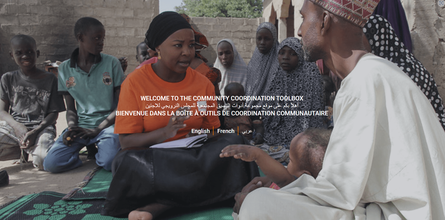
With the term community coordination, we aim to describe the role that community members should have in the coordination of humanitarian services and assistance affecting their lives – being able to contribute to the collaborative process of information sharing, planning and decision making, to solve problems and address needs, and being able to liaise with a range of external stakeholders through activities such as meetings, referrals, reporting, and monitoring.
The overall objective of engaging the communities in humanitarian coordination is to ensure appropriate and relevant services and assistance reach all demographic groups, including vulnerable and marginalized groups and people with specific needs, and ultimately to enable the affected population to hold the humanitarian agencies accountable.
The crucial contribution of Camp Management activities in this regard is fostering mechanisms that amplify the perspectives of the affected communities across different tiers of decision-making of humanitarian response. In practice this means building and supporting accountable and inclusive community representation structures and linking them with multi-stakeholder and multi-sectorial community coordination mechanisms, to make sure that feedback, learning and inputs from the community feed into decision making and shape response design.
Camp Management agencies are responsible for providing the community representation structures with support, training, coaching, and networking in order to strengthen their linkages to other governance structures as well as with humanitarian coordination mechanisms, and to build their community-led problem solving capacity.
Research done by NRC[1] for the International Organization for Migration (IOM) in 2019 as part of a Women’s Participation Project [2] shows that ensuring the inclusion of women and other marginalised groups in coordination of services to displaced people will have a strong impact on the appropriateness and reach of humanitarian services. The inclusion must however be planned and conducted in a structured manner, built in as a key part of programming. Currently, women – and particularly older women, as well as other marginalised groups – are prevented from meaningful participation in coordination of services. The study presents several barriers to their participation, all stemming from a pervasive patriarchal culture. While this is not a new observation, the study provides a nuanced understanding of how precisely culture affects women’s participation in coordination and suggests solutions to identified barriers. On the one hand, culture leads to women’s structural exclusion from humanitarian coordination processes and mechanisms; on the other hand, it means that women often lack the capacities that enable their male counterparts to have influence through coordination.
However, the study also found that with the right support, women could develop strong networks, which enable them to coordinate widely and leverage additional support and services for their communities. In short, women must be supported in two ways to be able to meaningfully participate in humanitarian coordination: firstly, by including them in structures of coordination, e.g. through a Women’s Coordination Network, and secondly by building their capacities and confidence – which are often limited by a combination of restrictive culture and lack of education and experience.
Although there is a solid and growing library of tools for Camp Management agencies on establishing, capacity building and supporting community representation structures in and outside of camps, a gap was identified from these research findings on how to structurally include women and marginalised groups to ensure meaningful participation in site or neighbourhood level representation structures, as well as inter-site or area level coordination mechanisms.
Building on these existing tools and resources, the Community Coordination Toolbox was developed to specifically address this gap through a set of practical training tools for camp management staff and community representation structures.